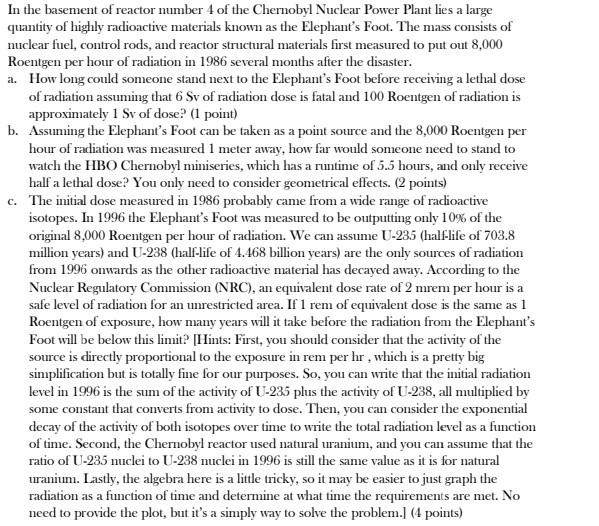Answered step by step
Verified Expert Solution
Question
1 Approved Answer
In the basement of reactor number 4 of the Chernobyl Nuclear Power Plant lies a large quantity of highly radioactive materials known as the Elephant's

In the basement of reactor number 4 of the Chernobyl Nuclear Power Plant lies a large quantity of highly radioactive materials known as the Elephant's Foot. The mass consists of nuclear fuel, control rods, and reactor structural materials first measured to put out 8,000 Roentgen per hour of radiation in 1986 several months after the disaster. a. How long could someone stand next to the Elephant's Foot before receiving a lethal dose of radiation assuming that 6 Sv of radiation dose is fatal and 100 Roentgen of radiation is approximately 1 Sy of dose? (1 point) b. Assuming the Elephant's Foot can be taken as a point source and the 8,000 Roentgen per hour of radiation was measured 1 meter away, how far would someone need to stand to watch the HBO Chernobyl miniseries, which has a runtime of 5.5 hours, and only receive half a lethal dose? You only need to consider geometrical effects. (2 points) c. The initial dose measured in 1986 probably came from a wide range of radioactive isotopes. In 1996 the Elephant's Foot was measured to be outputting only 10% of the original 8,000 Roentgen per hour of radiation. We can assume U-235 (half-life of 703.8 million years) and U-238 (half-life of 4.468 billion years) are the only sources of radiation from 1996 onwards as the other radioactive material has decayed away. According to the Nuclear Regulatory Commission (NRC), an equivalent dose rate of 2 mrem per hour is a safe level of radiation for an unrestricted area. If 1 rem of equivalent dose is the same as 1 Roentgen of exposure, how many years will it take before the radiation from the Elephant's Foot will be below this limit? [Hints: First, you should consider that the activity of the source is directly proportional to the exposure in rem per hr, which is a pretty big simplification but is totally fine for our purposes. So, you can write that the initial radiation level in 1996 is the sum of the activity of U-235 plus the activity of U-238, all multiplied by some constant that converts from activity to dose. Then, you can consider the exponential decay of the activity of both isotopes over time to write the total radiation level as a function of time. Second, the Chernobyl reactor used natural uranium, and you can assume that the ratio of U-235 nuclei to U-238 mclei in 1996 is still the same value as it is for natural uranium. Lastly, the algebra here is a little tricky, so it may be easier to just graph the radiation as a function of time and determine at what time the requirements are met. No need to provide the plot, but it's a simply way to solve the problem.) (4 points)
Step by Step Solution
There are 3 Steps involved in it
Step: 1

Get Instant Access to Expert-Tailored Solutions
See step-by-step solutions with expert insights and AI powered tools for academic success
Step: 2

Step: 3

Ace Your Homework with AI
Get the answers you need in no time with our AI-driven, step-by-step assistance
Get Started


